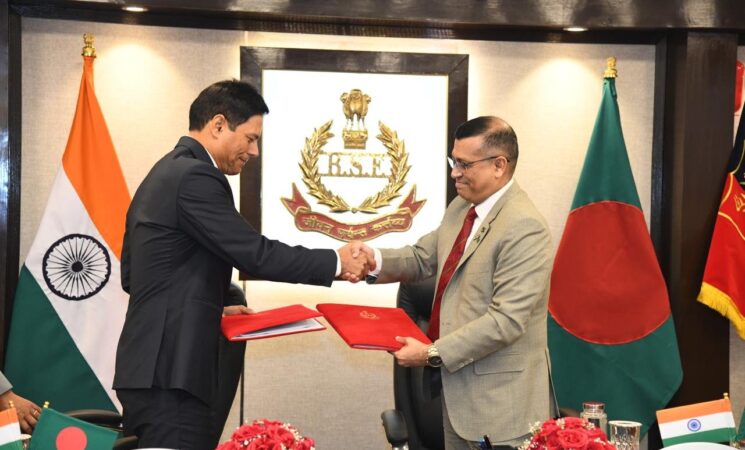24 March 2025, NIICE Commentary 10025
Gandharbika Ghosh
The border between India and Bangladesh is a long stretch of 4096.7km, out of which 3232.218km has been fenced. The Bengal Borderland embodies multiple issues of contention that portray the ongoing manifestations of the haphazard business of Partition. The ‘cartographic anxiety’ of post-colonial states and their pursuit of evolving and solidifying as nation-states, requires containment of and constraints on fluid geographies, people, and identities. Bordering and fortification/ fencing is one such mechanism of consolidating the margins and establishing fixity. Recently, a high-level delegation of the Border Guard Bangladesh (BGB) met with the Border Security Force (BSF) for the bi-annual Director General level talks. The meeting took place between February 18 and 20 in New Delhi. The next round of talks is likely to be held in July in Dhaka.
Practices and Problems of Bordering
The construction of fences along the border entails multiple difficulties. The riverine terrain, the largely un-demarcated border areas, the resultant border disputes, and the non-cooperative behavior of the various state governments and the Bangladesh Rifles (BDR) all pose challenges to effective fencing of the border. The rehabilitation of people displaced by fencing is another contentious matter between the central and the bordering state governments. India has also met stiff resistance from Bangladesh at 265 disputed spots as the security forces of both countries differ in their stand on where the boundary is located. Bangladesh’s objection is based on the fact that the erection of any defensive structure like fences within 150 yards of the international boundary is not allowed under the 1975 guidelines. India, however, maintains that the 1975 guidelines implicate such instructions on the demolition of defensive structures and not the construction of fences.
In the recent Director-General level talks, the border-guarding forces of Bangladesh and India agreed to exchange real-time information and investigation reports on human traffickers to protect human rights and prevent violence along the border. This is to ensure efficient border management that does not result in any fatalities on any side. The BSF and BGB also agreed to begin joint inspections of sectors and areas to settle the problems of fencing. The BSF raised the issue of attacks on its personnel at the meeting. There was said to be no discussion on altering the 1975 border agreement. The BGB chief stated that no permanent construction within 150 yards of the international border is permitted.
The BSF emphasized preventing attacks on its personnel and Indian civilians, tackling trans-border crimes, addressing Indian Insurgent Groups (IIGs) in Bangladesh, improving border infrastructure, constructing a single-row fence, and strengthening joint border management efforts for efficient implementation of Coordinated Border Management Plan (CBMP) and Confidence Building Measures (CBM). The BGB raised concerns about border crimes, illegal crossings by Indian entities, border killings, wastewater treatment from Agartala to Akhaura (establishment of Effluent Treatment plant), border demarcation and pillar construction, activities near the international border, riverbank protection, water sharing, camp locations, and armed miscreant movements in India.
In a formal objection to the construction of a single-row fence (SRF) by the BSF within 150 yards of the Indo-Bangladesh border, the BGB requested a new joint inspection "where there are issues" and a renegotiation of the terms, including how close the fence can be built to the "zero line”. However, BSF has refused to renegotiate the terms, which according to them are in accordance with the joint record of discussions (JRD) that the BSF and BGB previously finalized and that the then-Bangladesh government legally ratified.
State Sovereignty and Rhetoric of National Security
The national security narrative of the states explains fortified borders as a measure to contain cross-border crimes, smuggling, and illegal migration and movement. Whereas fencing and patrolling are necessary for protection against insurgents, terrorists, and criminals, the borderland residents get caught up between the security personnel and criminals. The India-Bangladesh border cuts through spaces and places where routine market exchanges and cross-border movements are part of people's lives. In some places, it passes through fluid geographies like ‘chars’, where the border itself shifts depending on the movement of the rivers. The exercise of state power to demarcate the inside and outside (insiders and outsiders), leads to securitization of routine activities, wherein they are viewed as threats to national security which results in the production of these regions as zones of contention. This has major implications for the lives and bodies of both the territory and the people.
Borderlands constitute sites where agency, power, and control intersect which reflects the nature of the relationship that nation-states have with borderland societies. The everyday practices, and local market exchanges combined with state laws give rise to a hybrid economy in the Bengal borderland region. In becoming negotiated and ‘sensitive spaces’ they also become zones of multiple contestations and contentions. They challenge the broader political geographies of borders and the nation. As sensitive spaces, they cast light on the anxieties, ambiguities, and uncertainties at the heart of territorial rule as they unsettle the idea of contiguous national territory and neatly bounded boundaries. Cons highlights how the ‘production of territory’ is a fundamentally violent process. Disputes over fluid landscapes and porous border areas symbolize the residues of the haphazard, geographically and culturally insensitive business of Partition.
Conclusion
Agreements and measures are required to address various concerns. Steps such as issuing work permits to Bangladeshi migrants and identity cards to Indians residing along the borders could be undertaken. Both India and Bangladesh need to actively engage with each other; hold equal stakes and responsibilities to ensure a peaceful border and build infrastructure and trade both across and along the border to ensure security against miscreants and also allow the borderland residents to carry on their routine activities and live their everyday lives.
Gandharbika Ghosh is a Research Intern at NIICE and she is a postgraduate in Political Science from the University of Delhi, India.

